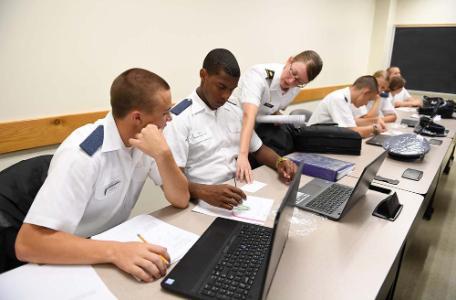Math Major Numbers Up
 |
|
Maj. Amy Givler assists (from left) Alec Westall ’20 and Tyain Smith ’20, students in her precalculus class, with a graphing activity using Wikki Stix. – VMI Photo by John Robertson IV. |
LEXINGTON, Va., Sept. 28, 2016 – These days, it’s hard to imagine the top level of Mallory Hall, home to VMI’s Department of Applied Mathematics, as anything but a busy and bustling place. Cadets congregate around study tables, and faculty visit each other’s offices to collaborate and share ideas.
Ten years ago, though, what was then the Department of Mathematics was a much quieter place – too quiet, actually. The department was small and graduated fewer than 10 math majors per year, in some years, fewer than five, recalled Col. Troy Siemers, now department head and a member of the VMI faculty since 1999.
Siemers explained that a need to increase the number of majors and revitalize what then seemed a moribund program led to the decision to create the Department of Applied Mathematics.
Fast forward 10 years, and both the department’s prestige and its enrollment have increased. In April, USA Today ranked VMI’s applied math department among the top 10 in the nation. The department was ranked eighth, just below the University of Southern California but ahead of Columbia University and Rice University.
Numbers, too, bear witness to a flourishing program. The department entered the 2016-17 academic year with approximately 64 majors and 58 minors, the latter number likely to rise as the year goes on and more cadets declare minors, Siemers explained.
“There are almost three times as many [math majors] in the Class of 2018 than there were total when I was first here,” the department chair commented. “There are more than 150 students actively pursuing advanced study in math at VMI.”
With that increase in interest has come a need to hire new faculty, and those faculty members have brought with them a contagious enthusiasm for applying mathematics to the real world.
One of those currently sharing her enthusiasm with cadets is Maj. Amy Givler, who is now in her second year as assistant professor of applied mathematics. This fall, Givler is teaching an introductory probability and statistics class that draws a good number of cadets majoring in fields such as international studies and history. Givler is aware that some may not like math, but she doesn’t let that act as a deterrent to success.
“That’s the great thing about teaching statistics – there are so many real-world applications that are very interesting to the students,” she commented. “With the political season upon us, there are many interesting things we can talk about with polls. … I try to spend a good amount of time looking at news articles, studies, and polls, and doing analysis on those, rather than cookie-cutter examples from the textbook.”
In the spring, Givler will teach the first of two courses in her field, operations research, which focuses on logistics and the allocation of resources.
“The program is designed around the expertise of the faculty,” Siemers said. “We were trying to hire the best people we could find; … those people wound up being bio-mathematicians and people with statistical backgrounds, and they had expertise with sports analytics and expertise in operations research.”
Thanks to the research interests of the new faculty members, a number of new programs have been created. The Applied and Industrial Mathematics program allows cadets to work over the summer to solve a real-world math problem for an outside client, while the Shenandoah Valley Math Modeling Challenge brings college and university students from the surrounding area to VMI to collaborate on a solution to a real-world scenario involving math. There’s even a math-oriented study abroad program in the summer months.
During the school year, cadets can save money on often pricey textbooks by purchasing electronic textbooks written by VMI faculty members. So far, there are five such e-books: one each for calculus I, II, and III and another for matrix algebra, all written by Col. Greg Hartman, professor of applied mathematics. The fifth e-book, on MatLab, a computer programming language, was written by Siemers, who estimates that cadets have saved $50,000 in textbook costs through the e-book program.
Despite all of these changes, one thing about the department has stayed the same: the desire on the part of faculty members to get to know cadets well and play a vital role in helping them succeed. Givler, for one, likes having the chance to teach small classes and see cadets she taught last year pass by in the halls.
“I really enjoy working with [cadets] who are focused and motivated, both in their academics and … to go out and make a change in the real world.”
– Mary Price
-VMI-
.svg)
.png)